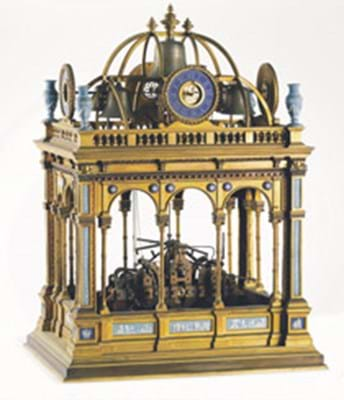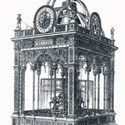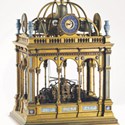Made by J.W. Benson, it stood close to 30 ft tall and, when in 1875 it was installed in St James's Cathedral, Toronto as a gift of the citizens of the city, it cost $14,495.
James William Benson is recorded as working at 62 and 64 Ludgate Hill, London with a retail outlet at West End House, 25 Old Bond Street. The firm were turret clock specialists - also responsible for the mighty Hussainabad clock tower in Lucknow, India - but like Dent could turn their hands to the small scale too.
The pint-size version of the St James's Clock, measuring 2ft 4in (70cm) high, was made in about 1880.
In a list from 1882 the company makes mention of "new forms decorated with Wedgewood (sic) and other wares".
Here the three-train, weight-driven turret clock movement with deadbeat escapement is housed within a Palladian temple with pillars and arches made from brass and embellished with blue jasperware urns and panels.
The movement (currently seized) was intended to drive the hands of four separate jasperware dials set on each side of the double-domed top and strike the hours and quarters on five bells.
The Saltney, Cheshire saleroom believed the clock would originally have been housed on a pedestal (probably on a similar classical theme) into which the weights would have hung.
The whereabouts of both weights and pedestal are now unknown but such an unusual clock generated great interest on September 29. It doubled its pre-sale top estimate to sell for £50,000 plus 20 per cent buyer's premium (inc. VAT).
This is the second most expensive item the firm have sold next to a Chippendale-period carved pier glass from the same Cheshire home which, as reported on last week's front page, sold for £80,000.
By Roland Arkell
Benson’s little and large
When first unveiled at the International Exhibition in London in 1862 (and subsequently shipped to Paris in 1867 and Vienna in 1873), the St James’s Clock, as it became known, was heralded as the second largest clock in the world after E.J. Dent’s Big Ben.








